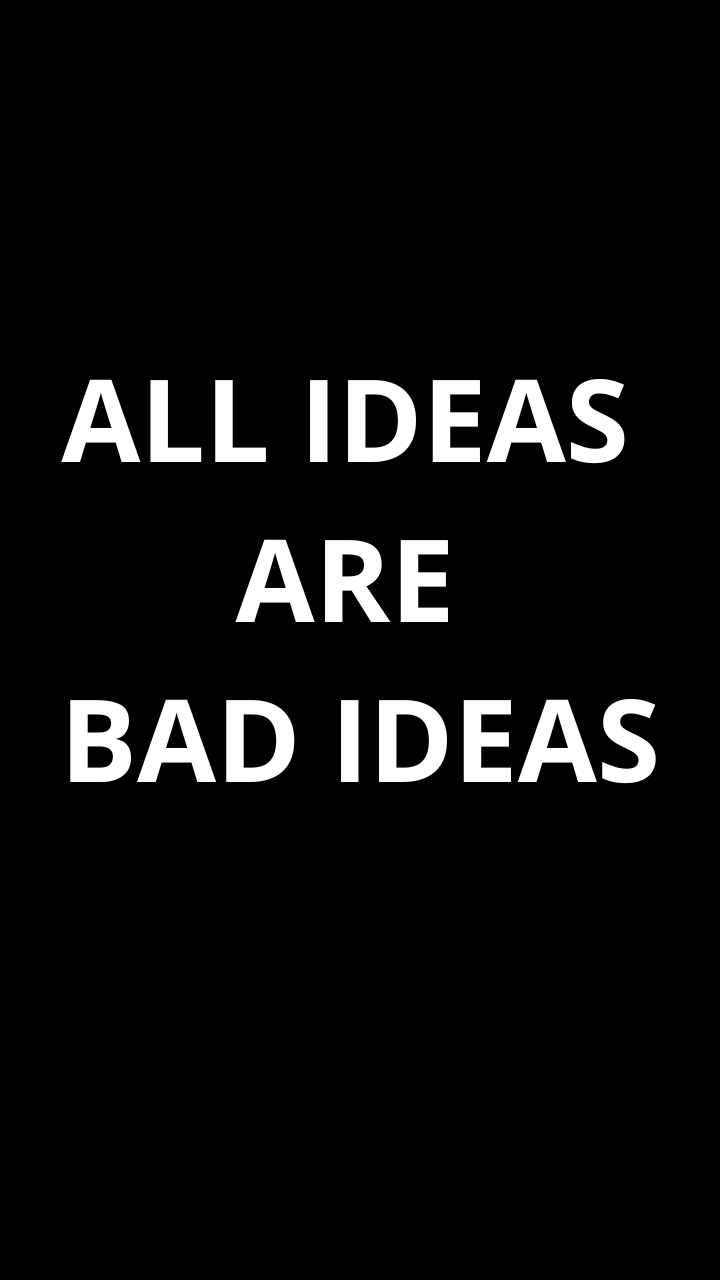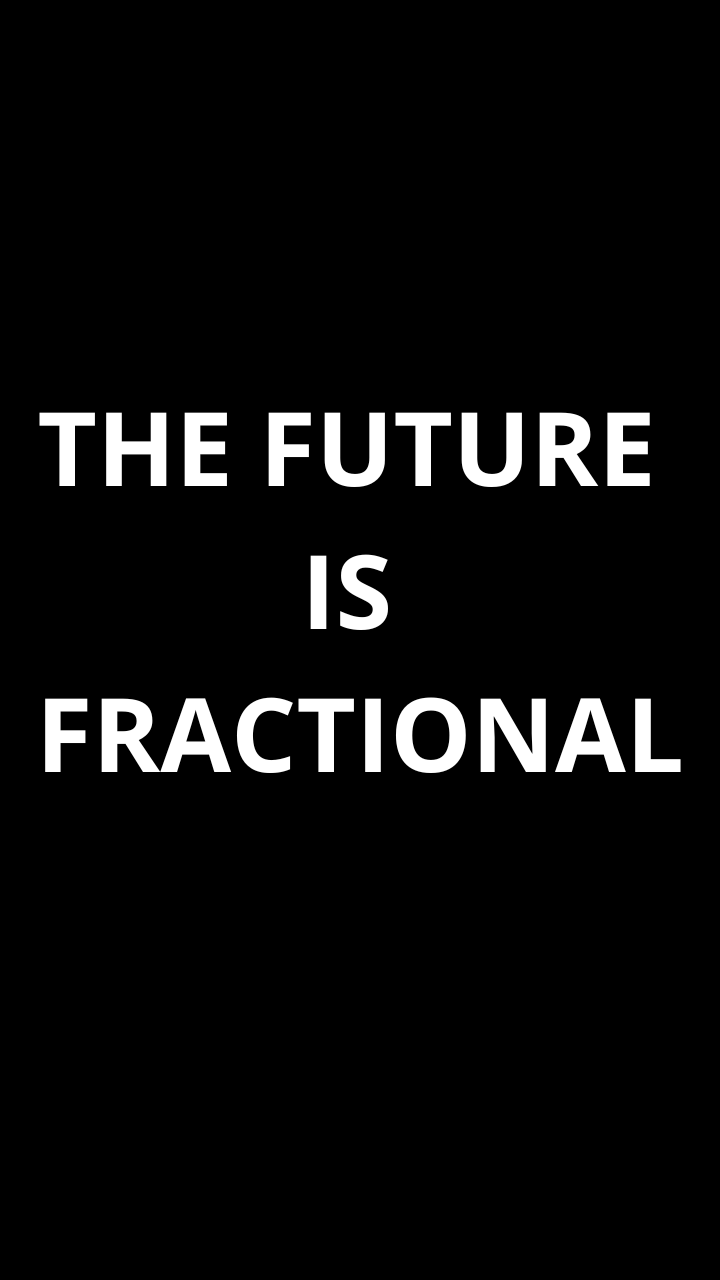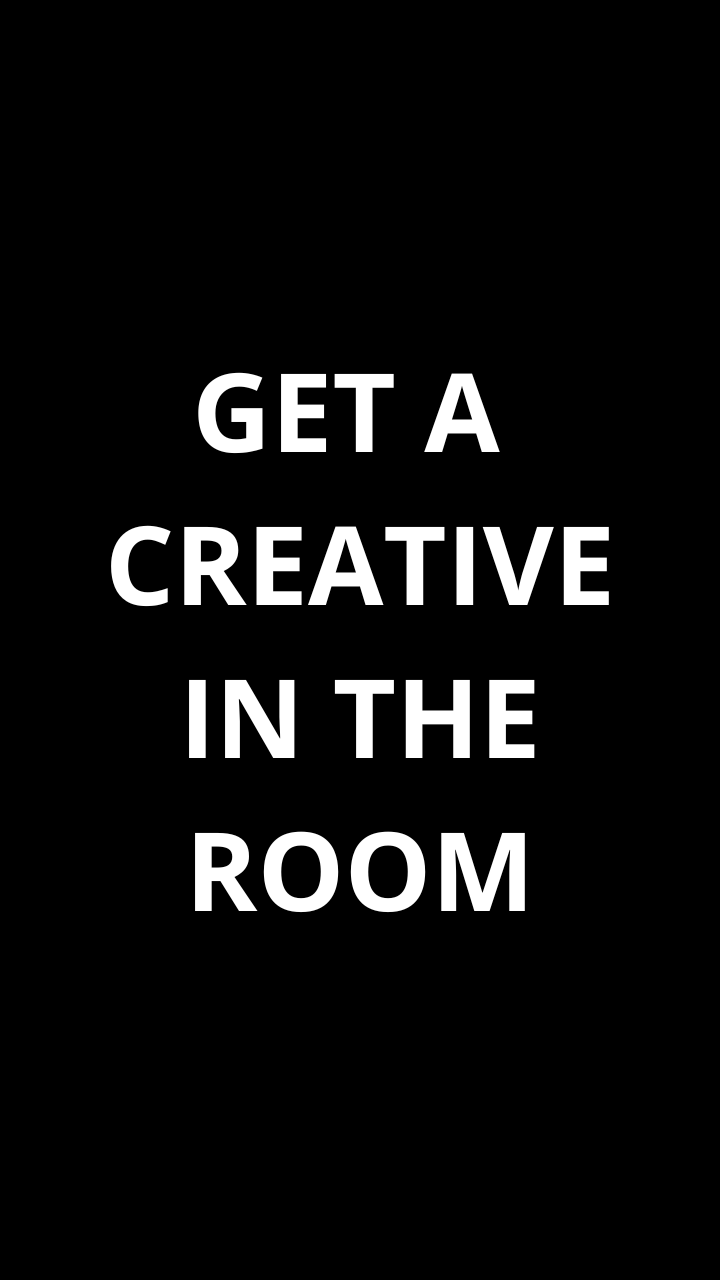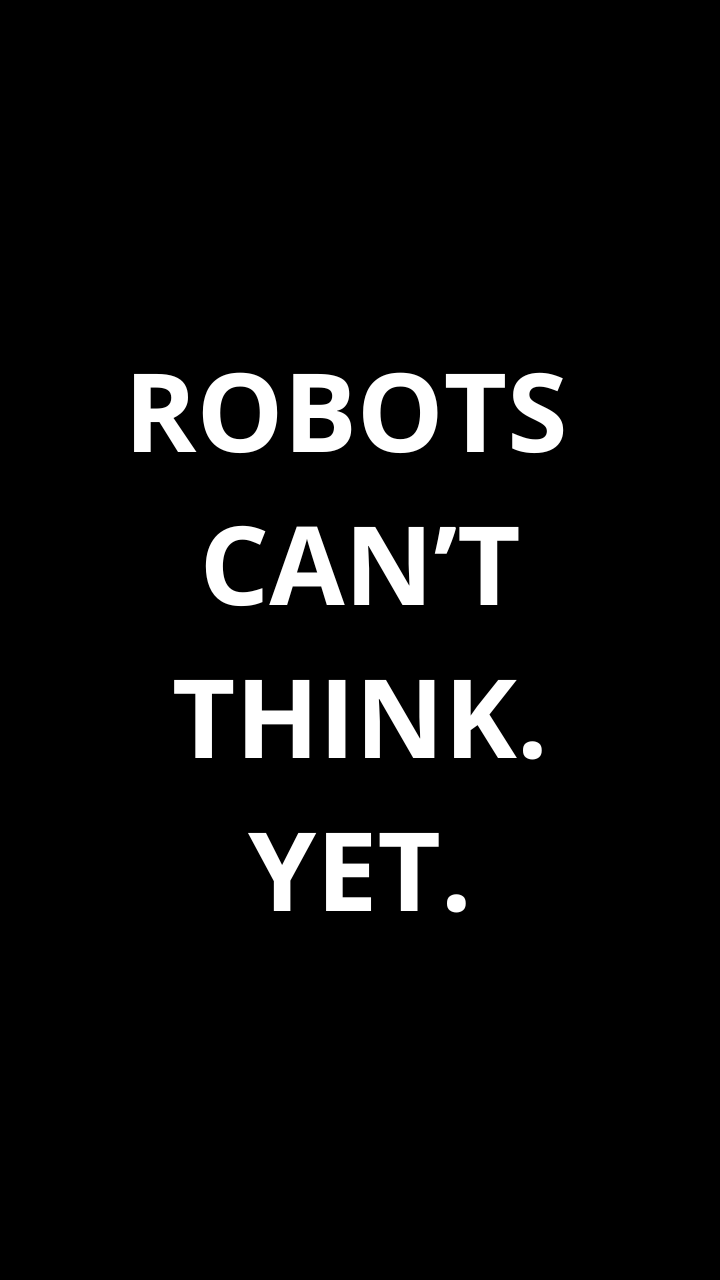Insights from TBC
Insights from TBC
All Ideas Are Bad Ideas

April 10, 2025
I have been in more than my fair share of brainstorming sessions where the person running it tries to create a safe space by insisting, ‘There are no bad ideas’. As soon as that is uttered I can see and feel the creative people around me freeze up, we all know there are plenty of bad ideas and what if one of them is mine? Instead of encouraging creative flow, it subtly reinforces the idea that bad ideas do exist, and that voicing them might be risky. Ironically, it creates the very fear it seeks to eliminate.
Now, imagine flipping the script. What if we walked into a brainstorming session and declared, ‘All ideas are bad ideas’? By setting the expectation that, yes, there will be plenty of bad ideas, we remove the pressure to come up with fully-formed, brilliant concepts on the first try. This shift in mindset can and does transform how teams approach creativity.
The Problem with ‘No Bad Ideas’
The phrase ‘no bad ideas’ has become a hallmark of brainstorming sessions, but its reassuring tone masks some unintended consequences:
- Pressure to Be Right: By implying that all ideas are good, participants might hesitate to share something half-baked, offbeat, or unconventional. They fear judgment because they’re subconsciously holding their contributions to an unrealistic standard.
- False Optimism: Insisting that no idea is bad can create a culture of forced positivity. This can lead to surface-level discussions where ideas aren’t properly challenged or developed.
- Misaligned Expectations: Teams can spend time nurturing weak ideas simply because they’re told all ideas are equally valid. This slows progress and dilutes focus.
- Crushes confidence: Confidence is key. When you reject their ‘not a bad idea idea’ you crush their confidence and it takes a while to come back. Reject an idea that we acknowledge is bad and we all move on.
- Creative Stagnation: Paradoxically, the ‘no bad ideas’ rule can stifle creativity by failing to push participants out of their comfort zones. If everything is accepted at face value, there’s no incentive to dig deeper or explore bolder options.
Why ‘All Ideas Are Bad Ideas’ Works
When we embrace the notion that all ideas are inherently flawed, we start from a place of humility and curiosity. Here’s why this mindset is a game-changer:
- It Lowers the Stakes: If all ideas are bad, there’s no pressure to deliver brilliance on the spot. Participants feel freer to share silly or incomplete thoughts, which often lead to unexpected breakthroughs.
- It Normalises Iteration: Declaring all ideas as bad sets the expectation that ideas are just starting points. The real value comes from refining, combining, and building upon them.
- It Encourages Playfulness: When you know your idea will be bad, you’re more likely to take risks and think outside the box. Playfulness is often the spark for true innovation.
- It Promotes Constructive Criticism: Instead of tiptoeing around ideas to avoid offending anyone, teams are encouraged to engage in candid discussions. This collaborative critique leads to stronger, more polished concepts.
The Bigger Picture
At its core, the ‘All ideas are bad ideas’ approach is about embracing the messy, iterative nature of creativity. It reminds us that innovation rarely emerges fully formed; instead, it’s the result of countless missteps, revisions, and collaborations.
So the next time you’re in a brainstorming session, try starting with the assumption that all ideas are bad. You might be surprised at how much good comes from it.
Ready to talk business?
The Future Is Fractional

May 06, 2025
Why Fractional?
Historically, companies would bring on a full-time Chief Marketing Officer (CMO) or Brand Strategist to shape their strategy, build teams, manage agencies, and guide creative direction. But in today's environment - where technology automates execution and AI can write a first draft or run a media buy - the need for ongoing, full-time senior oversight is shrinking. What remains essential is the strategic thinking, vision, and experience those leaders bring.
Fractional CMOs and brand strategists offer exactly that:
- Strategic clarity without the massive overhead.
- Fresh thinking drawn from multiple industries and verticals.
- A flexible model that scales with the business.
This isn’t about cutting corners. It’s about cutting waste.
Better for Businesses
For startups and scaling companies, hiring a full-time CMO or brand lead can be premature and expensive. Fractional leadership allows them to tap senior experience early, without the full-time commitment. For established brands, a fractional role can fill gaps, accelerate specific projects, or lead transformation efforts without adding another executive to the payroll.
It’s a lean, smart approach that gives companies access to top-tier talent they might not otherwise afford, on a cadence that suits their needs.
Better for the Strategist
The benefits aren’t just on the client side. For the practitioner fractional opens up a more diverse, enriching, and sustainable career path.
Instead of being locked into one brand’s cycle for years, fractional leaders engage across sectors, absorbing new challenges, solving different problems, and continuously sharpening their craft. This diversity of experience becomes a superpower, and clients benefit from broader insights and tested frameworks.
It also offers more autonomy and work-life balance, something increasingly valued by seasoned professionals who want to work smarter, not just harder.
The Human Edge in a Tech-Driven World
AI is changing the game. Automation is doing more. But strategy still needs people, especially those with pattern recognition, intuition, and the ability to align a brand’s internal culture with its external promise.
That kind of leadership can’t be scaled by software or outsourced to a tool. But it can be delivered more efficiently, more flexibly and more powerfully through a fractional model.
In Summary
The future of marketing leadership isn’t less, it’s leaner, smarter, and fractional. Businesses get what they need, when they need it. Strategists build careers on variety, insight, and autonomy. And brand building becomes more agile than ever before.
Fractional is the future. And for those bold enough to embrace it, the future looks bright.
Ready to talk business?
Get a Creative in the Room

May 12, 2025
And sometimes, despite their best efforts, the work misses the mark for the client.
Why? The work met the brief, was approved through all the internal reviews but still left the client less than impressed.
The Game of Creative Telephone
This old-school model of brief ping-pong creates a dangerous opportunity for misinterpretation. A nuanced comment made by the client in passing, a facial expression, or even the tone of voice used during the meeting can shift the perceived intent of the brief. Details like this rarely make it into written notes or summary decks. So the creative team, working in good faith and producing high-quality, even potential award winning work, might inadvertently solve the wrong problem.
Cue frustration. Revisions. Rejection. And, at worst, the erosion of trust between agency and client.
Cut the Middle Layer: Invite the Creative In
Having a creative in the room when the brief is delivered changes everything. They hear it firsthand. They can ask questions in the moment. They can read the client’s energy. Most importantly, they can begin thinking creatively from the start, not based on an interpretation of the brief, but the brief itself.
What’s more, having the creative in the room creates shared accountability. The creative can’t claim the work went sideways because the brief was misinterpreted or lost in translation. They were there. They’re now part of the strategy, not just the execution.
The Creative Mind Is Strategic Too
There’s also a deeper benefit here, creatives are more than execution machines. The best ones think strategically. They bring sharp insight, empathy, and lateral thinking to the table, often unearthing a richer problem to solve or a more inspiring way to solve it. Excluding them from early conversations is not just inefficient, it’s a waste of one of your agency’s greatest assets.
This Isn’t About Undermining Account Service
Let’s be clear, this isn’t a call to bypass or devalue account service. They play a vital role in developing the strategy, managing relationships, navigating feedback, and maintaining alignment. But by pairing account leads with creatives from the outset, you unlock the full potential of your team. Everyone hears the same thing. Everyone owns the result.
In Summary
Creatives should be in the room when the brief is delivered. Not after it’s been filtered. Not after it’s been reworded. But in the room, live, engaging, listening and owning the outcome. It leads to better work, fewer missteps and stronger partnerships.
Ready to talk business?
Robots Can't Think. Yet.

May 22, 2025
That’s why my approach to brand strategy always starts with something more fundamental – person-to-person collaboration. From that comes discovery and the beginning of the journey to find that unique voice that AI can amplify.
The Illusion of Intelligence
AI can sound clever. It can mimic brand speak and stitch together content that looks polished. But at its core, it’s still predictive. It’s trained on the past, not tuned to your future. It’s a mirror, not a compass.
That’s where we come in.
Our job as brand strategists is to listen, challenge, and co-create. We work closely with our clients to find the brand's true edge. The thing that sets it apart. The thing the market actually cares about.
Because AI can only draw on what already exists, it can’t find that unique positioning. That thing that makes you, you. Only people can, together.
There are no original ideas
This famous viewpoint of Mark Twain’s hypothesises that there are no original ideas and that all ideas are a re-imagining of what has come before. Perhaps he’s right. But the reimagining required to develop a differentiating brand platform must still start with people. The most powerful brand platforms don’t come from templates or trend reports. They come from conversation and exploration – the discovery of an emotive engaging position to develop from.
That’s not something you brief ChatGPT to figure out.
The right brand positioning is more than just a smart line, it’s a strategic tool. It influences how your team sells, markets, innovates, and hires. It gives the business a north star. When you get that right, then AI becomes a game changer. It can help you scale the message, generate consistent content, test creative variations, and move faster than ever before.
But it still needs a foundation, one built on human insight and mutual understanding.
How this affects how I work
I believe in the power of human + machine, but in that order.
I partner closely with B2B organisations to develop bold, defensible brand strategy. I don’t just drop in a tagline and leave. I immerse myself in my clients’ business, I question and I bring an independent objective viewpoint. I then develop a strong strategic platform where AI can really make the difference. Whether it is speed to market, cost efficiency or maximising the volume of content you can produce, this is where the AI advantage comes into play. Use it to scale execution across campaigns, content, internal comms, and design systems, you name it. But the value TBC (Tim Brown Consulting) brings starts long before that.
Think Together, Then Scale
Robots can’t think. Not yet.
The brands that win today aren’t choosing between human or machine, they’re choosing which to use, and when. With TBC, I bring the creative and strategic brains to help B2B businesses find their voice, then use AI to help amplify it.
Strategy still starts with people, good strategy leads to success and growth. And that leads to celebration. I like to celebrate with a beer and the people I got there with. And much like thinking, robots can’t drink. Not yet.
Ready to talk business?